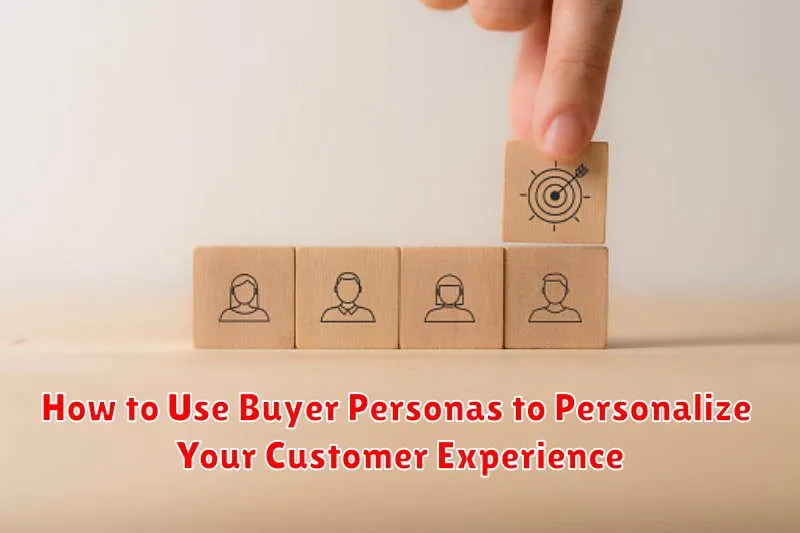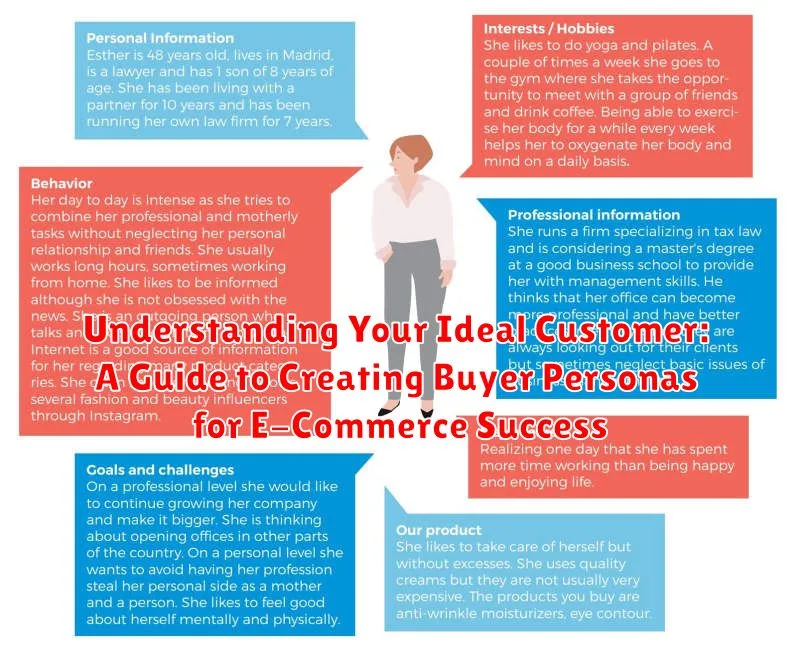In the competitive landscape of e-commerce, understanding your ideal customer is paramount to success. Developing comprehensive buyer personas is no longer a luxury, but a necessity. This guide will delve into the crucial process of creating effective buyer personas, enabling you to target your marketing efforts, personalize the customer experience, and ultimately drive e-commerce success. Learn how to define your target audience with precision, moving beyond simple demographics to uncover the motivations, pain points, and online behaviors that truly define your ideal customer.
Creating actionable buyer personas empowers you to make data-driven decisions across all aspects of your e-commerce business. From product development and website design to content marketing and customer service, understanding your ideal customer allows you to tailor every touchpoint to resonate with their specific needs and preferences. This guide will provide practical steps and actionable insights to help you craft buyer personas that unlock the full potential of your e-commerce strategy and drive significant growth. Prepare to transform your understanding of your target audience and achieve e-commerce success.
What is a Buyer Persona and Why is it Important for E-Commerce?
A buyer persona is a semi-fictional representation of your ideal customer. It’s based on research and data about your existing and potential customers, and it goes beyond basic demographics. A well-defined buyer persona embodies the customer’s needs, motivations, behaviors, and goals.
Why are buyer personas crucial for e-commerce success? They provide actionable insights that help you:
- Target your marketing efforts: Craft messaging that resonates with your ideal customer’s pain points and desires.
- Improve product development: Design products and services that truly meet your customer’s needs.
- Personalize the customer experience: Tailor your website, content, and offers to create a more engaging experience.
- Increase conversions and sales: By understanding your customer better, you can effectively guide them through the sales funnel.
Essentially, buyer personas provide a strategic framework for understanding and connecting with your target audience, ultimately driving e-commerce growth.
Identifying Your Target Audience: Research and Data Collection
Identifying your target audience is the crucial first step in creating effective buyer personas. This involves gathering data and conducting research to understand your potential customers’ characteristics, needs, and motivations.
Data collection plays a vital role in this process. Leverage website analytics to understand user behavior, demographics, and interests. Tools like Google Analytics provide valuable insights into website traffic, popular pages, and customer demographics.
Customer surveys are another effective method for gathering data directly from your audience. Ask specific questions related to their needs, pain points, and purchasing behavior.
Analyzing existing customer data, such as purchase history and customer service interactions, can offer valuable insights into your current customer base. Identify common characteristics and trends.
Market research complements your data collection efforts. Explore industry reports, competitor analysis, and social media trends to understand broader market dynamics and customer preferences.
Defining Your Buyer Persona: Demographics, Psychographics, and Behavior
Once you’ve gathered data on your target audience, the next step is to define your buyer persona by analyzing demographics, psychographics, and behavior. Demographics provide the foundational understanding of your ideal customer. Think age, gender, location, education, income, and family status. These characteristics help you segment your audience and tailor your message.
Psychographics delve deeper into your customer’s values, interests, lifestyle, and personality. Understanding what motivates them, their aspirations, and their pain points allows you to connect with them on an emotional level. Consider their hobbies, what they read, and their online behavior.
Finally, analyzing behavior gives you insights into their purchasing habits. This includes their buying frequency, preferred channels (e.g., mobile, desktop), and how they interact with your website. Understanding these patterns helps you optimize your marketing efforts for conversions.
Creating Effective Buyer Persona Profiles: Tips and Best Practices
Creating effective buyer persona profiles requires a structured approach and attention to detail. Here are some tips and best practices to ensure your personas are valuable tools:
Keep it Concise and Focused:
Avoid overly lengthy profiles. Focus on the most relevant information that directly impacts your e-commerce strategy.
Use Visual Aids:
While we aren’t including images here, consider incorporating visuals like charts or infographics in your actual profiles. This can make the information more digestible and memorable.
Regularly Review and Update:
Customer behavior and market trends change. Regularly revisit and update your buyer personas to ensure they remain accurate and relevant.
Share with Your Team:
Ensure everyone in your organization, from marketing to customer service, understands and utilizes the buyer personas. This creates a unified customer experience.
Validate with Real Data:
Whenever possible, validate your persona assumptions with real customer data and feedback. This ensures accuracy and avoids relying solely on assumptions.
Using Buyer Personas to Improve Your E-Commerce Marketing Strategy

Once you have developed comprehensive buyer persona profiles, you can leverage them to significantly enhance your e-commerce marketing strategy. By understanding your ideal customers’ needs, motivations, and behaviors, you can tailor your marketing efforts for maximum impact.
Targeted Content Marketing: Craft compelling content that resonates with each persona’s specific interests and pain points. This could include blog posts, articles, videos, or social media updates addressing their particular challenges and offering valuable solutions.
Personalized Email Campaigns: Segment your email list based on your personas and create targeted email campaigns that deliver personalized messages and offers. This approach increases engagement and drives conversions by providing relevant information to each segment.
Optimized Product Descriptions and Website Copy: Use language that speaks directly to your personas’ needs and desires. Highlight the benefits that are most important to them and address their potential concerns. This can improve product page conversion rates.
Effective Social Media Marketing: Tailor your social media content and advertising to resonate with the platforms and content formats preferred by each persona. This ensures your message reaches the right audience in the right place.
Improved Customer Service: Train your customer service team to understand your buyer personas and their unique needs. This allows them to provide more personalized and effective support, leading to increased customer satisfaction.
How to Use Buyer Personas to Personalize Your Customer Experience

Once you’ve developed your buyer personas, the next step is putting them to work. Personalization is key to connecting with your target audience. This means tailoring your messaging, offers, and overall shopping experience to resonate with their specific needs and preferences.
Targeted Content Marketing: Use your personas to inform your content strategy. Create blog posts, social media updates, and email campaigns that address their pain points, interests, and goals. For example, if a persona is a tech-savvy millennial, tailor your content to reflect current trends and utilize platforms they frequent.
Product Recommendations: Leverage persona insights to suggest relevant products. If a persona is a price-conscious parent, highlight affordable options and family-friendly deals. This personalized approach increases the chances of conversion.
Customer Service Interactions: Train your customer service team to utilize persona information. Understanding a customer’s typical behavior and preferences allows for more empathetic and efficient support. For example, knowing a persona prefers quick solutions via chat can guide your team to offer that option proactively.
Website Optimization: Structure your website navigation and content with your personas in mind. If a persona is primarily mobile, prioritize a seamless mobile experience. If they are goal-oriented, ensure a clear path to purchase.
Real-World Examples of Buyer Personas in Action
Let’s explore how fictional businesses leverage buyer personas to drive their marketing and sales strategies.
Example 1: The Fashion-Forward Millennial
An online clothing boutique catering to young adults developed a persona named “Sarah.” Sarah is a 25-year-old social media influencer with a keen interest in sustainable fashion. The boutique uses this persona to curate collections featuring eco-friendly brands and promotes them through Instagram campaigns, resonating with Sarah’s demographic.
Example 2: The Tech-Savvy Executive
A software company selling project management tools created a persona called “Mark,” a 40-year-old CTO always seeking ways to optimize team productivity. Understanding Mark’s needs, the company emphasizes the software’s collaborative features and integration capabilities in their marketing materials, highlighting its value proposition for executives like him.
Example 3: The Health-Conscious Home Cook
An online organic grocery store developed a persona called “Maria,” a 35-year-old mother focused on providing healthy meals for her family. The store uses Maria’s profile to promote organic produce boxes tailored to family needs and offers recipe ideas featuring seasonal ingredients, directly appealing to Maria’s priorities.
Common Mistakes to Avoid When Creating Buyer Personas
Creating effective buyer personas requires careful consideration and research. Avoiding common pitfalls will ensure your personas accurately represent your target audience and contribute to your e-commerce success. Here are some mistakes to avoid:
Relying on Assumptions
Basing personas on gut feelings instead of data leads to inaccurate representations. Conduct thorough research through surveys, interviews, and data analysis to gain a true understanding of your customer base.
Creating Too Many Personas
While having multiple personas is sometimes necessary, creating too many can dilute your marketing efforts. Focus on the most important segments that represent the majority of your customer base.
Being Too Broad
Vague personas lack actionable insights. Define specific demographics, psychographics, pain points, and motivations to create truly useful profiles.
Neglecting to Update Personas
Customer behavior and market trends change over time. Regularly review and update your personas to ensure they remain relevant and reflect current customer needs.

